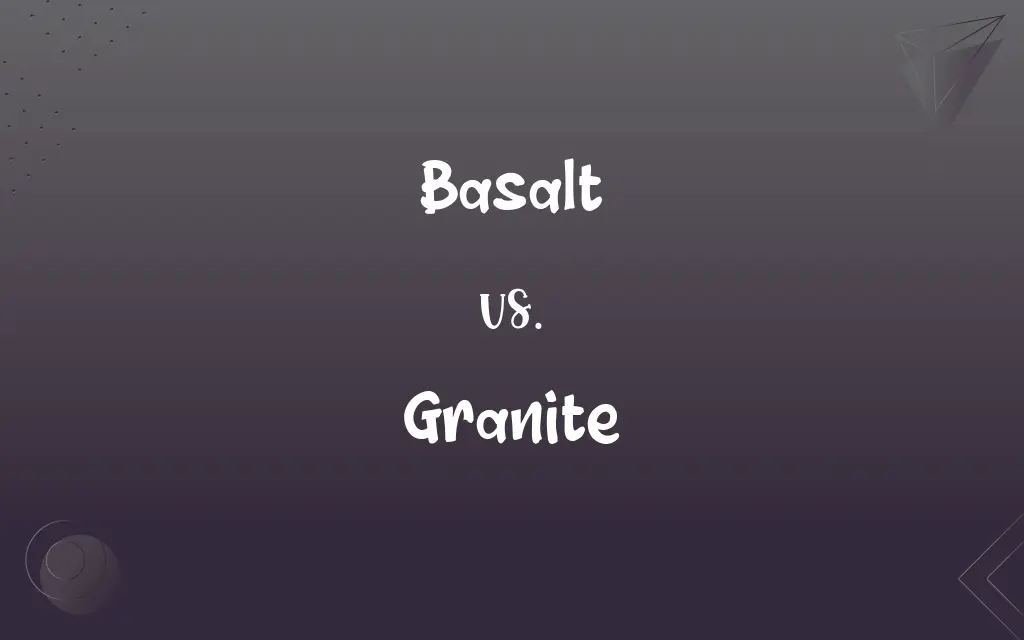Basalt vs. Granite: What's the Difference?
Edited by Aimie Carlson || By Harlon Moss || Published on November 28, 2023
Basalt is a dark, fine-grained volcanic rock. Granite is a light-colored, coarse-grained igneous rock.

Key Differences
Basalt is formed from rapid cooling of lava at the Earth's surface, resulting in a fine-grained texture. Granite, however, forms deep within the Earth's crust from slow cooling of magma, leading to its coarse-grained texture.
In terms of composition, basalt is rich in magnesium and iron, giving it a darker color. While, granite is composed mainly of quartz and feldspar, contributing to its lighter color.
Basalt exhibits higher density and durability, making it suitable for construction materials. Whereas, granite, with its lower density but high strength, is favored for decorative purposes like countertops.
Basalt is typically found in oceanic plates and volcanic regions. In contrast, granite is common in continental crust, forming large mountain ranges.
The cooling rate of basalt allows for fewer crystal formations, resulting in a smoother texture. Meanwhile, granite cools slowly, allowing large crystals to form, giving it a granular texture.
ADVERTISEMENT
Comparison Chart
Formation
Rapid cooling of lava
Slow cooling of magma
Texture
Fine-grained
Coarse-grained
Composition
Rich in magnesium and iron
Composed of quartz and feldspar
Color
Darker
Lighter
Density
Higher
Lower
ADVERTISEMENT
Basalt and Granite Definitions
Basalt
High density.
The high density of basalt makes it heavier than many rocks.
Granite
Igneous rock.
Granite is an igneous rock formed from cooled magma.
Basalt
Volcanic rock.
Basalt is commonly found in volcanic regions.
Granite
Coarse-grained.
The coarse-grained nature of granite is visible to the naked eye.
Basalt
Fine-grained.
The fine-grained texture of basalt is due to rapid cooling.
Granite
Decorative stone.
Granite is popular in home decoration for its beauty.
Basalt
Dark color.
Basalt's dark color is a result of its iron and magnesium content.
Granite
Light color.
Granite's light color varies from pink to gray.
Basalt
Durable.
Basalt is used in construction for its durability.
Granite
Crystalline texture.
The crystalline texture of granite is due to slow cooling.
Basalt
A hard, dense, dark igneous rock composed chiefly of plagioclase feldspar, pyroxene, and olivine, and often having a glassy appearance.
Granite
A common, coarse-grained, light-colored, hard igneous rock consisting chiefly of quartz, orthoclase or microcline, and mica, used in monuments and for building.
Basalt
A kind of hard unglazed pottery.
Granite
Unyielding endurance; steadfastness
A will of granite.
Basalt
(mineral) A hard mafic igneous rock of varied mineral content; volcanic in origin, which makes up much of the Earth's oceanic crust.
Granite
(rock) A group of igneous and plutonic rocks composed primarily of feldspar and quartz. Usually contains one or more dark minerals, which may be mica, pyroxene, or amphibole. Granite is quarried for building stone, road gravel, decorative stone, and tombstones. Common colors are gray, white, pink, and yellow-brown.
Basalt
A type of unglazed pottery.
Granite
Toughness; the quality of having a thick skin or being rough.
Basalt
A rock of igneous origin, consisting of augite and triclinic feldspar, with grains of magnetic or titanic iron, and also bottle-green particles of olivine frequently disseminated.
Granite
A crystalline, granular rock, consisting of quartz, feldspar, and mica, and usually of a whitish, grayish, or flesh-red color. It differs from gneiss in not having the mica in planes, and therefore in being destitute of a schistose structure.
Basalt
An imitation, in pottery, of natural basalt; a kind of black porcelain.
Granite
Plutonic igneous rock having visibly crystalline texture; generally composed of feldspar and mica and quartz
Basalt
The commonest type of solidified lava; a dense dark gray fine-grained igneous rock composed chiefly of calcium-rich plagioclase feldspar and pyroxene
Granite
Something having the quality of granite (unyielding firmness);
A man of granite
FAQs
How does basalt's formation affect its appearance?
Rapid cooling leads to a fine-grained, uniform appearance.
Can basalt be polished like granite?
Yes, but it's less common due to its finer grain and texture.
What is basalt primarily used for?
Basalt is widely used in construction due to its strength and durability.
Are there color variations in granite?
Yes, granite can range from light to dark, depending on its mineral composition.
Is basalt heavier than granite?
Yes, basalt typically has a higher density and is heavier.
Why is granite preferred for kitchen countertops?
Its beauty and resistance to scratching and heat make it ideal for countertops.
How does the mineral composition differ between them?
Basalt is rich in iron and magnesium, while granite has more quartz and feldspar.
How are basalt and granite formed geologically?
Basalt forms from lava at the surface, while granite forms from magma underground.
Is granite suitable for outdoor structures?
Yes, granite is often used outdoors due to its durability and aesthetic appeal.
How do the textures of basalt and granite differ?
Basalt is fine-grained, while granite is coarse-grained.
Can granite come in black like basalt?
Yes, but it’s less common and usually has visible grains.
Does granite have any industrial uses?
Yes, it's used in construction, monuments, and as a dimension stone.
Can basalt and granite be mistaken for each other?
Not usually, due to their distinct textures and colors.
Are there environmental impacts from quarrying these rocks?
Yes, quarrying any rock, including basalt and granite, impacts the environment.
Are there any famous monuments made of basalt?
Yes, many ancient monuments and sculptures are made of basalt.
How does the cost of basalt compare to granite?
Basalt is generally more affordable than granite, which is considered more luxurious.
Can both rocks be used in landscaping?
Yes, both are popular in landscaping for different aesthetic and functional purposes.
Is basalt more resistant to weathering than granite?
Basalt is generally more durable, but granite also has good weathering resistance.
Is granite radioactive?
Some granite can contain trace radioactive elements.
Is basalt used in road construction?
Yes, its durability makes it suitable for road construction.
About Author
Written by
Harlon MossHarlon is a seasoned quality moderator and accomplished content writer for Difference Wiki. An alumnus of the prestigious University of California, he earned his degree in Computer Science. Leveraging his academic background, Harlon brings a meticulous and informed perspective to his work, ensuring content accuracy and excellence.
Edited by
Aimie CarlsonAimie Carlson, holding a master's degree in English literature, is a fervent English language enthusiast. She lends her writing talents to Difference Wiki, a prominent website that specializes in comparisons, offering readers insightful analyses that both captivate and inform.







































































